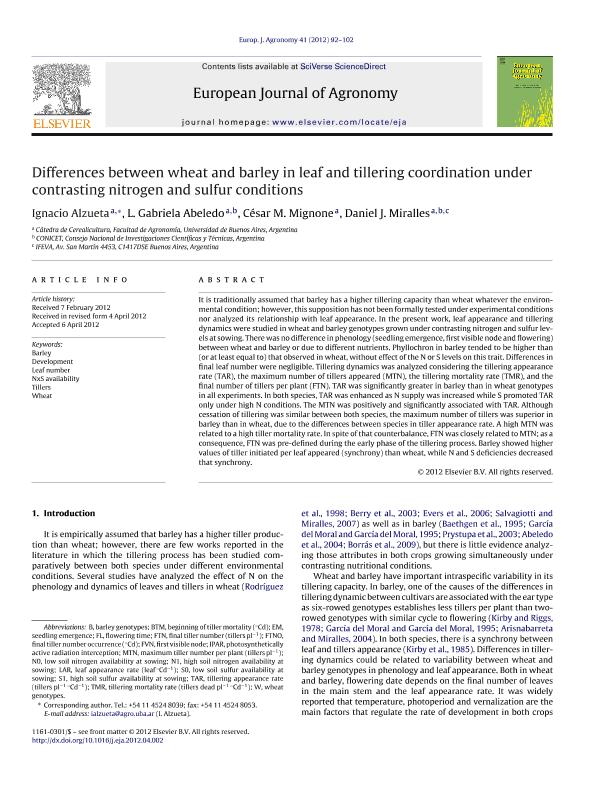Artículo
Differences between wheat and barley in leaf and tillering coordination under contrasting nitrogen and sulfur conditions
Fecha de publicación:
08/2012
Editorial:
Elsevier Science
Revista:
European Journal Of Agronomy
ISSN:
1161-0301
Idioma:
Inglés
Tipo de recurso:
Artículo publicado
Clasificación temática:
Resumen
It is traditionally assumed that barley has a higher tillering capacity than wheat whatever the environmental condition; however, this supposition has not been formally tested under experimental conditions nor analyzed its relationship with leaf appearance. In the present work, leaf appearance and tillering dynamics were studied in wheat and barley genotypes grown under contrasting nitrogen and sulfur levels at sowing. There was no difference in phenology (seedling emergence, first visible node and flowering) between wheat and barley or due to different nutrients. Phyllochron in barley tended to be higher than (or at least equal to) that observed in wheat, without effect of the N or S levels on this trait. Differences in final leaf number were negligible. Tillering dynamics was analyzed considering the tillering appearance rate (TAR), the maximum number of tillers appeared (MTN), the tillering mortality rate (TMR), and the final number of tillers per plant (FTN). TAR was significantly greater in barley than in wheat genotypes in all experiments. In both species, TAR was enhanced as N supply was increased while S promoted TAR only under high N conditions. The MTN was positively and significantly associated with TAR. Although cessation of tillering was similar between both species, the maximum number of tillers was superior in barley than in wheat, due to the differences between species in tiller appearance rate. A high MTN was related to a high tiller mortality rate. In spite of that counterbalance, FTN was closely related to MTN; as a consequence, FTN was pre-defined during the early phase of the tillering process. Barley showed higher values of tiller initiated per leaf appeared (synchrony) than wheat, while N and S deficiencies decreased that synchrony.
Palabras clave:
Barley
,
Nxs Availability
,
Tillers
,
Wheat
Archivos asociados
Licencia
Identificadores
Colecciones
Articulos(IFEVA)
Articulos de INST.D/INV.FISIOLOGICAS Y ECO.VINCULADAS A L/AGRIC
Articulos de INST.D/INV.FISIOLOGICAS Y ECO.VINCULADAS A L/AGRIC
Articulos(OCA PQUE. CENTENARIO)
Articulos de OFICINA DE COORDINACION ADMINISTRATIVA PQUE. CENTENARIO
Articulos de OFICINA DE COORDINACION ADMINISTRATIVA PQUE. CENTENARIO
Citación
Alzueta, Ignacio; Abeledo, Leonor Gabriela; Mignone, César M.; Miralles, Daniel Julio; Differences between wheat and barley in leaf and tillering coordination under contrasting nitrogen and sulfur conditions; Elsevier Science; European Journal Of Agronomy; 41; 8-2012; 92-102
Compartir
Altmétricas




